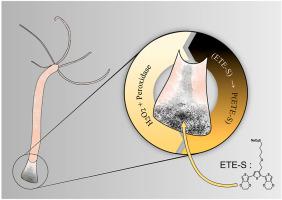Bioactive Materials ( IF 18.9 ) Pub Date : 2021-08-28 , DOI: 10.1016/j.bioactmat.2021.08.025 Giuseppina Tommasini 1 , Gwennaël Dufil 2 , Federica Fardella 1 , Xenofon Strakosas 2 , Eugenio Fergola 1 , Tobias Abrahamsson 2 , David Bliman 3 , Roger Olsson 3, 4 , Magnus Berggren 2 , Angela Tino 1 , Eleni Stavrinidou 2 , Claudia Tortiglione 1

|
Leveraging the biocatalytic machinery of living organisms for fabricating functional bioelectronic interfaces, in vivo, defines a new class of micro-biohybrids enabling the seamless integration of technology with living biological systems. Previously, we have demonstrated the in vivo polymerization of conjugated oligomers forming conductors within the structures of plants.
Here, we expand this concept by reporting that Hydra, an invertebrate animal, polymerizes the conjugated oligomer ETE-S both within cells that expresses peroxidase activity and within the adhesive material that is secreted to promote underwater surface adhesion. The resulting conjugated polymer forms electronically conducting and electrochemically active μm-sized domains, which are inter-connected resulting in percolative conduction pathways extending beyond 100 μm, that are fully integrated within the Hydra tissue and the secreted mucus. Furthermore, the introduction and in vivo polymerization of ETE-S can be used as a biochemical marker to follow the dynamics of Hydra budding (reproduction) and regeneration. This work paves the way for well-defined self-organized electronics in animal tissue to modulate biological functions and in vivo biofabrication of hybrid functional materials and devices.
中文翻译:

通过共轭寡聚物的体内聚合在动物模型中无缝集成生物电子界面
利用活生物体的生物催化机制在体内制造功能性生物电子界面,定义了一类新的微生物杂种,使技术与活生物系统无缝集成。以前,我们已经证明了在植物结构内形成导体的共轭低聚物的体内聚合。
在这里,我们通过报告无脊椎动物Hydra在表达过氧化物酶活性的细胞内和分泌以促进水下表面粘附的粘附材料内聚合共轭寡聚体 ETE-S 来扩展这一概念。由此产生的共轭聚合物形成电子导电和电化学活性 μm 大小的域,它们相互连接,导致超过 100 μm 的渗透传导通路完全整合在Hydra组织和分泌的粘液中。此外,ETE-S的引入和体内聚合可用作生物化学标记,以跟踪Hydra的动力学萌芽(繁殖)和再生。这项工作为动物组织中定义明确的自组织电子调节生物功能和混合功能材料和设备的体内生物制造铺平了道路。



























 京公网安备 11010802027423号
京公网安备 11010802027423号